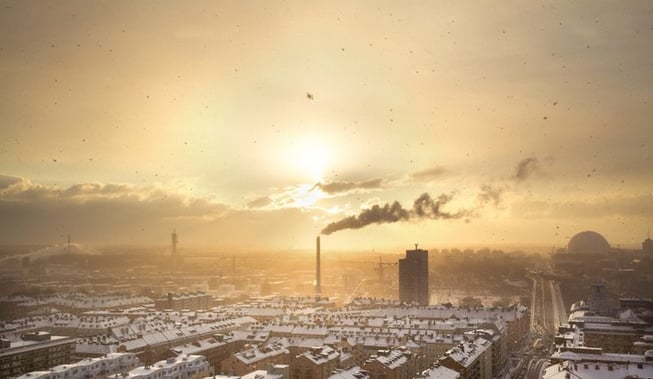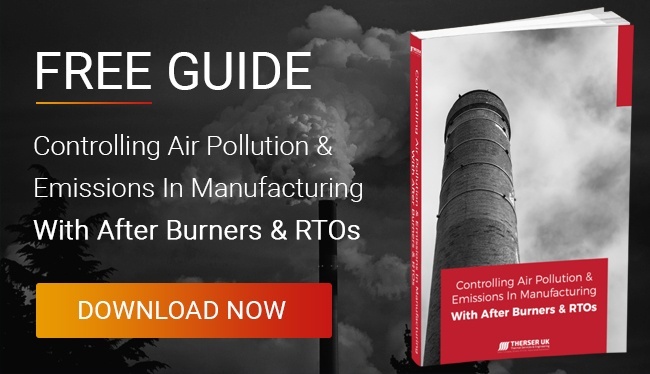Share this
Using RTOs For Air Pollution Control
by Therser Sales Team on 13-Feb-2018 16:05:17

RTOs are widely used by manufacturers to control airborne pollutants in waste exhaust streams. In a typical twin bed regenerative thermal oxidiser, contaminated process gases enter through an inlet manifold and are directed toward an energy recovery chamber for preheating. From here, the VOC-laden gases are drawn along the first ceramic regeneration bed, and progressively heated as they move toward the combustion chamber.
The elevated temperature approaches the auto-ignition temperature of most VOCs present in the process air stream as it moves through the successive ceramic regeneration layers toward the combustion chamber.
Inside The RTO
Inside the RTO’s insulated combustion chamber, a small amount of heat is added to the warmed gas stream as it passes through the combustion chamber, ensuring its uniform heating and maximising the oxidation of volatile compounds within it during the system’s residence time.
After the oxidation of the VOCs in the combustion chamber is complete, outgoing gases release their heat energy into the second ceramic regeneration bed before they are released into the atmosphere. This makes the second bed warmer than the first so that a flow control valve switch can be used to alternate the direction of flow and increase the oxidiser’s fuel efficiency. If the concentration of VOCs in the process gas stream is high enough, the energy from their combustion then allows for the self-sustained operation of the RTO.
For applications in which high hydrocarbon efficiency is required, a third regeneration bed can be added to the regenerative thermal oxidiser system. The addition of the third bed allows the inlet bed to be purged before it is switched to the outlet bed. Tower type RTOs are the most common 3-bed RTOs used for general industrial applications.
Operating temperatures for regenerative thermal oxidisers are comparable to those of direct flame and recuperative thermal oxidiser types—typically between 750ºC (1800ºF) and 1200ºC (2200ºF). As with these other types of thermal oxidisers, the VOC destruction efficiency for RTOs depends largely on their design characteristics, including residence time, the temperatures reached during combustion and the degree of mixing of combustible organics within them.
Because the heat energy captured by the ceramic media in a regenerative thermal oxidiser originates from the combustion of the VOCs in the target emission air stream, their overall efficiency can be reduced significantly with gas flows containing lower concentrations of VOCs.
Thermal Oxidiser Destruction Efficiency
Thermal efficiency is an important consideration in thermal oxidiser design through its impact on overall operational costs. Thermal oxidation units generally require extremely high temperatures that are achieved through the combustion of natural gas, and can, therefore, become costly over time.
Rotor concentrators are often used to increase the thermal efficiency of thermal oxidation systems by reducing the amount of air flowing through the oxidiser system, thereby increasing the concentration of VOCs in the incoming process exhaust stream. The rotor concentrator is a continuously rotating wheel coated with an adsorbing agent. As process exhaust flows through the wheel, VOCs and other organic pollutants are adsorbed on the wheel’s surface, while clean air is released to the atmosphere. Later, exposing the wheel to a desorption gas cleans the contaminants off, producing a small, highly concentrated stream of volatile organics ready for input to the thermal oxidation unit.
Thermal oxidisers generally have destruction efficiencies ranging from 90% to greater than 95%. Sometimes destruction efficiencies are expressed in milligrams per cubic metre of VOCs. Many types of thermal oxidation systems are also effective at destroying or removing particulate matter and odours from process exhaust streams.
More Information
To find out more, please send an email to sales@therseruk.com. You may also want to download our free eBook: Controlling Air Pollution & Emissions In Manufacturing With After Burners & RTOs by clicking here.
Share this
- Company News (90)
- Battery Materials (41)
- kiln (37)
- fabrication (29)
- Alloy (27)
- Furnace (27)
- Welding (16)
- Industrial Kilns (15)
- Battery (13)
- Ceramic Kilns (13)
- Processes (13)
- alloy fabrication (13)
- Shuttle Kilns (12)
- RTO’s (11)
- Vacancies (11)
- Hydrogen (10)
- Therser UK (9)
- Tunnel Kiln (9)
- Refractory (8)
- Therser (8)
- Wellman Furnaces (8)
- Brickwork (7)
- Case Studies (7)
- Afterburners (6)
- Fibre Lining (6)
- electric (6)
- Almor Wellman (5)
- thermal engineers (5)
- Biochar (4)
- Exhibition (4)
- Pyrolysis (4)
- Servicing (4)
- Spares (4)
- heat treatment (4)
- History (3)
- Ceramics Uk (2)
- Combustion Control Upgrades (2)
- Nitrogen (2)
- Temperature Control Rings (2)
- gas (2)
- Certificates (1)
- Instrumentation (1)
- MMC (1)
- RHK (1)
- Roller Hearth Kiln (1)
- Test Trials (1)
- aerospace (1)
- analyser (1)
- elec (1)
- oxygen (1)
- vans (1)
- September 2025 (2)
- May 2025 (2)
- March 2025 (1)
- February 2025 (2)
- January 2025 (5)
- December 2024 (5)
- November 2024 (7)
- October 2024 (5)
- September 2024 (4)
- August 2024 (14)
- July 2024 (13)
- June 2024 (2)
- May 2024 (5)
- April 2024 (13)
- March 2024 (8)
- February 2024 (12)
- January 2024 (14)
- December 2023 (6)
- November 2023 (12)
- October 2023 (24)
- September 2023 (11)
- August 2023 (11)
- July 2023 (9)
- June 2023 (15)
- May 2023 (53)
- April 2023 (5)
- March 2023 (6)
- February 2023 (7)
- January 2023 (3)
- December 2022 (8)
- November 2022 (5)
- October 2022 (11)
- September 2022 (1)
- August 2022 (2)
- July 2022 (1)
- June 2022 (2)
- May 2022 (1)
- March 2022 (1)
- February 2022 (1)
- January 2022 (1)
- December 2021 (3)
- October 2021 (1)
- August 2021 (1)
- June 2021 (1)
- May 2021 (4)
- April 2021 (2)
- March 2021 (4)
- February 2021 (2)
- December 2020 (3)
- November 2020 (1)
- September 2020 (3)
- May 2020 (1)
- April 2020 (2)
- March 2020 (1)
- January 2020 (1)
- December 2019 (1)
- July 2019 (2)
- June 2019 (1)
- April 2019 (2)
- March 2019 (3)
- February 2019 (4)
- December 2018 (1)
- November 2018 (1)
- September 2018 (2)
- August 2018 (1)
- July 2018 (1)
- May 2018 (3)
- April 2018 (1)
- February 2018 (3)
- January 2018 (2)
- December 2017 (3)
- November 2017 (1)
- October 2017 (2)
- September 2017 (4)
- August 2017 (1)
- July 2017 (2)
- June 2017 (2)
- May 2017 (3)
- April 2017 (3)



